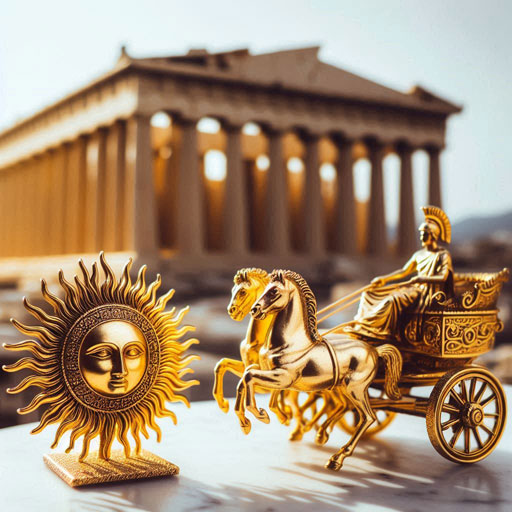Table of Contents
- Origins and Family
- Powers and Attributes
- Myths and Legends
- Worship and Cultural Significance
- Depictions in Art and Literature
- Facts from Greek Mythology
- Conclusion
1. Origins and Family
In Greek mythology, Helios is often depicted as the son of the Titans Hyperion and Theia. This lineage makes him a second-generation Titan, with siblings that include Selene (the Moon) and Eos (the Dawn). The family association underscores Helios's role as a prominent celestial deity.
Titaness Selene: Origin, Symbolism In Greek Mythology
Titan Hyperion: Powers, Symbol of Light, and His Role in Greek Mythology
2. Powers and Attributes
Helios is revered as the god who personifies the Sun. His powers extend to the ability to illuminate the world with his chariot-driven Sun across the sky. He is also associated with the passage of time and the daily cycle of sunrise and sunset.

God Helios on his chariot
3. Myths and Legends
Helios is central to various myths and legends. One of the most notable stories involves his son Phaethon, who attempts to drive the Sun chariot but fails catastrophically, causing widespread devastation. This myth underscores Helios's role as a powerful and sometimes unpredictable deity.
4. Worship and Cultural Significance
Helios was widely worshipped in ancient Greece, especially in regions where sunlight was crucial for agriculture and daily life. His cult centers often featured grand temples and rituals honoring the Sun god. Festivals such as the Heliaia celebrated his significance and influence.

Helios was widely worshipped in ancient Greece
Depictions in Art and Literature
Artistic representations of Helios typically depict him riding his golden chariot across the sky, radiating light and warmth. He is often portrayed with a radiant crown or halo, symbolizing his divine status as the bringer of light. In literature, Helios symbolizes vitality, enlightenment, and the divine power of the Sun.
6. Facts from Greek Mythology
Here are some intriguing facts about Helios from Greek mythology:
- Helios was often referred to as "Titan Helios" to distinguish him from other solar deities.
- His daily journey across the sky was believed to be on a chariot drawn by fiery horses.
- Helios was known for his unwavering watch over oaths and promises, as he witnessed all from his vantage point.
- He played a significant role in the tale of Medea, providing her with the chariot that enabled her escape.
Greek islands and sunny days create the perfect combination.
7. Conclusion
Helios, the Greek god of the Sun, embodies the celestial force that sustains life and inspires awe. Through myths, worship, and artistic expressions, Helios remains a timeless symbol of illumination, vitality, and the enduring power of the Sun in Greek mythology.
Interested in Greek Mythology ? Visit our blog here


